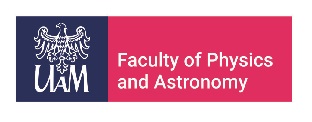
Dr. Małgorzata Paprzycka
- Tel: +48 61 829 5274
- Loc: wing G, second floor, room 290
- Email: mpap@amu.edu.pl
Publications
2025 |
Marceli Koralewski, Małgorzata Paprzycka, Mikołaj Baranowski Faraday effect of imidazole and pyrrolidine and their N-alkyl derivatives Journal of Molecular Liquids, 427 , pp. 127398, 2025, ISSN: 0167-7322. @article{KORALEWSKI2025127398, title = {Faraday effect of imidazole and pyrrolidine and their N-alkyl derivatives}, author = {Marceli Koralewski and Małgorzata Paprzycka and Mikołaj Baranowski}, url = {https://www.sciencedirect.com/science/article/pii/S0167732225005653}, doi = {https://doi.org/10.1016/j.molliq.2025.127398}, issn = {0167-7322}, year = {2025}, date = {2025-01-01}, journal = {Journal of Molecular Liquids}, volume = {427}, pages = {127398}, abstract = {Ionic liquids (ILs) are of great interest because of their spectacular physicochemical properties and applications. Recent research suggests the possible application of magnetic ILs (MILs) in photonics. That fact motivated us to start with magnetooptical (MO) studies on the precursor compounds of most known ILs based on imidazolium and pyrrolidinium cations to gain information allowed tailoring the magnitude of the Faraday effect (FE) in this kind of materials. Herein, we present results of the magnetooptical rotatory dispersion (MORD) and refractive index (RI). The MORD spectrum was described by the Faraday B-terms according to the Serber theory. The respective parameters describing the FE and RI were evaluated and correlated with the position of the experimentally observed optical edge for the compounds studied. The Verdet constant varies very slightly with temperature as expected for diamagnetic materials. Comparison measurements for other precursors of heterocyclic ring compounds of cations of Ils, i.e. pyridine, piperidine, pyrazole, and pyrrole, as well as their methyl derivatives, were also made. The results obtained allow to establish the empirical relation between the Verdet constant and the N-alkyl chain length, as well as the diamagnetic susceptibility and optical polarizability, which were evaluated for studied materials. Comparison of the obtained results with the data for benzene and cyclohexane allowed for the correlation of the V constant with the degree of aromaticity of the studied compounds. RI was also correlated with the N-alkyl chain length. The developed relations will be useful for designing new MILs and tailoring their MO properties.}, keywords = {}, pubstate = {published}, tppubtype = {article} } Ionic liquids (ILs) are of great interest because of their spectacular physicochemical properties and applications. Recent research suggests the possible application of magnetic ILs (MILs) in photonics. That fact motivated us to start with magnetooptical (MO) studies on the precursor compounds of most known ILs based on imidazolium and pyrrolidinium cations to gain information allowed tailoring the magnitude of the Faraday effect (FE) in this kind of materials. Herein, we present results of the magnetooptical rotatory dispersion (MORD) and refractive index (RI). The MORD spectrum was described by the Faraday B-terms according to the Serber theory. The respective parameters describing the FE and RI were evaluated and correlated with the position of the experimentally observed optical edge for the compounds studied. The Verdet constant varies very slightly with temperature as expected for diamagnetic materials. Comparison measurements for other precursors of heterocyclic ring compounds of cations of Ils, i.e. pyridine, piperidine, pyrazole, and pyrrole, as well as their methyl derivatives, were also made. The results obtained allow to establish the empirical relation between the Verdet constant and the N-alkyl chain length, as well as the diamagnetic susceptibility and optical polarizability, which were evaluated for studied materials. Comparison of the obtained results with the data for benzene and cyclohexane allowed for the correlation of the V constant with the degree of aromaticity of the studied compounds. RI was also correlated with the N-alkyl chain length. The developed relations will be useful for designing new MILs and tailoring their MO properties. |
2023 |
Marceli Koralewski, Małgorzata Paprzycka Journal of Molecular Liquids, 375 , pp. 121375, 2023. @article{Koralewski2023, title = {Faraday effect and refractive index of some imidazolium-based room-temperature ionic liquids and magnetic ionic liquids}, author = {Marceli Koralewski and Małgorzata Paprzycka}, doi = {10.1016/j.molliq.2023.121375}, year = {2023}, date = {2023-02-02}, journal = {Journal of Molecular Liquids}, volume = {375}, pages = {121375}, abstract = {Knowledge of the Faraday effect (FE) is very important in fundamental research and applications. Here, we report FE and refractive index studies for two magnetic ionic liquids (MILs), namely 1-ethyl- and 1-butyl-3-methylimidazolium tetrachloroferrate. Similar studies are also conducted for ionic liquids (ILs) that have a diamagnetic counteranion in place of [FeCl4]. The magnitudes of the Verdet constants of MILs are comparable and exhibit a negative sign. Furthermore, they are about one order larger than those of ILs with a diamagnetic counteranion of a positive sign. The Verdet constant shows monotonic variations as a function of wavelength in the range from 450 to 650 nm and is mainly related to charge transfer transitions in [FeCl4], with bands located in the UV region, though the contribution of d-d transitions in Fe+3 is negligible. A model for describing the measured Verdet constant data as a function of wavelength and temperature is given with respective values of effective Faraday A-, B-, and D-terms. The introduction of an empirical rule allows the estimation of Verdet constants of iron and imidazolium derivative based MILs, which are in some cases very high, thus indicating their potential in photonics applications. Imidazole shows a positive and nearly-two orders lower magnitude of the Verdet constant. The mixture of an MIL and acetonitrile allows the tuning of both the Verdet constant and the refractive index. The refractive indices, thermo-optic coefficients, and electronic polarizabilities of MILs are higher than those of ILs with a diamagnetic counteranion.}, keywords = {}, pubstate = {published}, tppubtype = {article} } Knowledge of the Faraday effect (FE) is very important in fundamental research and applications. Here, we report FE and refractive index studies for two magnetic ionic liquids (MILs), namely 1-ethyl- and 1-butyl-3-methylimidazolium tetrachloroferrate. Similar studies are also conducted for ionic liquids (ILs) that have a diamagnetic counteranion in place of [FeCl4]. The magnitudes of the Verdet constants of MILs are comparable and exhibit a negative sign. Furthermore, they are about one order larger than those of ILs with a diamagnetic counteranion of a positive sign. The Verdet constant shows monotonic variations as a function of wavelength in the range from 450 to 650 nm and is mainly related to charge transfer transitions in [FeCl4], with bands located in the UV region, though the contribution of d-d transitions in Fe+3 is negligible. A model for describing the measured Verdet constant data as a function of wavelength and temperature is given with respective values of effective Faraday A-, B-, and D-terms. The introduction of an empirical rule allows the estimation of Verdet constants of iron and imidazolium derivative based MILs, which are in some cases very high, thus indicating their potential in photonics applications. Imidazole shows a positive and nearly-two orders lower magnitude of the Verdet constant. The mixture of an MIL and acetonitrile allows the tuning of both the Verdet constant and the refractive index. The refractive indices, thermo-optic coefficients, and electronic polarizabilities of MILs are higher than those of ILs with a diamagnetic counteranion. |
Marceli Koralewski, Małgorzata Paprzycka, Alice Goyal, Krzysztof Gibasiewicz Faraday rotation enhancement for colloidal spherical Au and Ag nanoparticles and their mixtures Journal of Magnetism and Magnetic Materials, 588 , pp. 171461, 2023, ISSN: 0304-8853. @article{Koralewski2023b, title = {Faraday rotation enhancement for colloidal spherical Au and Ag nanoparticles and their mixtures}, author = {Marceli Koralewski and Małgorzata Paprzycka and Alice Goyal and Krzysztof Gibasiewicz}, url = {http://dx.doi.org/10.1016/j.jmmm.2023.171461}, doi = {10.1016/j.jmmm.2023.171461}, issn = {0304-8853}, year = {2023}, date = {2023-01-01}, journal = {Journal of Magnetism and Magnetic Materials}, volume = {588}, pages = {171461}, publisher = {Elsevier BV}, keywords = {}, pubstate = {published}, tppubtype = {article} } |
Marceli Koralewski, Małgorzata Paprzycka, Katarina Siposova, Oskar Sobotka The kinetics of aggregation of the Aβ1-40 peptide monitored by magnetooptical methods Journal of Magnetism and Magnetic Materials, 587 , pp. 171273, 2023, ISSN: 0304-8853. @article{Koralewski2023c, title = {The kinetics of aggregation of the Aβ1-40 peptide monitored by magnetooptical methods}, author = {Marceli Koralewski and Małgorzata Paprzycka and Katarina Siposova and Oskar Sobotka}, url = {http://dx.doi.org/10.1016/j.jmmm.2023.171273}, doi = {10.1016/j.jmmm.2023.171273}, issn = {0304-8853}, year = {2023}, date = {2023-01-01}, journal = {Journal of Magnetism and Magnetic Materials}, volume = {587}, pages = {171273}, publisher = {Elsevier BV}, keywords = {}, pubstate = {published}, tppubtype = {article} } |

